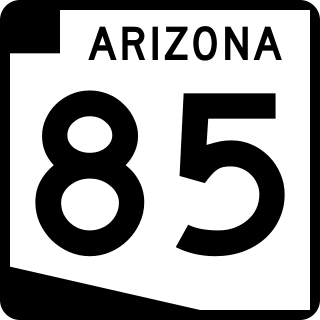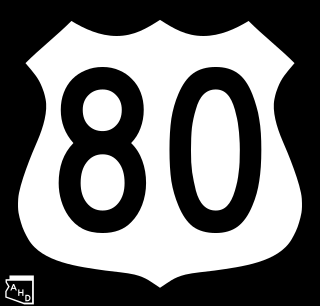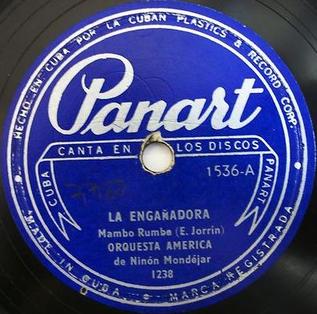Related Research Articles
Mambo is a genre of Cuban dance music pioneered by the charanga Arcaño y sus Maravillas in the late 1930s and later popularized in the big band style by Pérez Prado. It originated as a syncopated form of the danzón, known as danzón-mambo, with a final, improvised section, which incorporated the guajeos typical of son cubano. These guajeos became the essence of the genre when it was played by big bands, which did not perform the traditional sections of the danzón and instead leaned towards swing and jazz. By the late 1940s and early 1950s, mambo had become a "dance craze" in Mexico and the United States as its associated dance took over the East Coast thanks to Pérez Prado, Tito Puente, Tito Rodríguez and others. In the mid-1950s, a slower ballroom style, also derived from the danzón, cha-cha-cha, replaced mambo as the most popular dance genre in North America. Nonetheless, mambo continued to enjoy some degree of popularity into the 1960s and new derivative styles appeared, such as dengue; by the 1970s it had been largely incorporated into salsa.

Footprint Center is a multi-purpose arena in Phoenix, Arizona. It opened under the name America West Arena on June 6, 1992, at a cost of $89 million.
Boogaloo or bugalú is a genre of Latin music and dance which was popular in the United States in the 1960s. Boogaloo originated in New York City mainly by stateside Puerto Ricans with African American music influences. The style was a fusion of popular African American rhythm and blues (R&B) and soul music with mambo and son montuno, with songs in both English and Spanish. The American Bandstand television program introduced the dance and the music to the mainstream American audience. Pete Rodríguez's "I Like It like That" was a famous boogaloo song.

State Route 85 is a 128.86-mile-long (207.38 km) state highway in the U.S. state of Arizona. The highway runs from the United States–Mexico border near Lukeville to the north ending at Interstate 10 (I-10) in Buckeye. The highway also intersects I-8 in Gila Bend and serves as a connector between I-8 and I-10 and for travelers between Phoenix and Yuma as well as San Diego. SR 85 between I-10 and I-8, as well as I-8 between SR 85 and I-10 in Casa Grande, is touted as a bypass of the Phoenix area for long-distance travelers on I-10.
Gilberto Miguel Calderón, known professionally as Joe Cuba, was an American conga drummer of Puerto Rican descent widely regarded as the "Father of Latin Boogaloo".

Pablo Rodríguez Lozada, better known as Tito Rodríguez, was a Puerto Rican singer and bandleader. He started his career singing under the tutelage of his brother, Johnny Rodríguez. In the 1940s, both moved to New York, where Tito worked as a percussionist in several popular rhumba ensembles, before directing his own group to great success during the 1950s. His most prolific years coincided with the peak of the mambo and cha-cha-cha dance craze. He also recorded boleros, sones, guarachas and pachangas.
The Chitlin' Circuit was a collection of performance venues found throughout the eastern, southern, and upper Midwest areas of the United States. They provided commercial and cultural acceptance for African-American musicians, comedians, and other entertainers following the era of venues run by the "white-owned-and-operated Theatre Owners Booking Association (TOBA)...formed in 1921." The Chitlin Circuit sustained black musicians and dancers during the era of racial segregation in the United States from the 1930s through the 1960s.

State Farm Stadium is a multi-purpose retractable roof stadium in Glendale, Arizona, United States, west of Phoenix. It is the home of the Arizona Cardinals of the National Football League (NFL) and the annual Fiesta Bowl. It replaced Sun Devil Stadium in Tempe as the home of the Cardinals, and is adjacent to Desert Diamond Arena, former home of the Arizona Coyotes of the National Hockey League.

In the U.S. state of Arizona, Interstate 10 (I‑10), the major east–west Interstate Highway in the United States Sun Belt, runs east from California, enters Arizona near the town of Ehrenberg and continues through Phoenix and Tucson and exits at the border with New Mexico near San Simon. The highway also runs through the cities of Casa Grande, Eloy, and Marana. Segments of the highway are referred to as either the Papago Freeway, Inner Loop, or Maricopa Freeway within the Phoenix area and the Pearl Harbor Memorial Highway outside metro Phoenix.

KOY is a commercial radio station licensed to Phoenix, Arizona, featuring a Regional Mexican radio format known as "93.7 El Patrón". Owned by iHeartMedia, the station serves the Phoenix metropolitan area. KOY's studios are located in Phoenix near Sky Harbor International Airport, and broadcasts at 1,000 watts—non-directional—from a transmitter located near Downtown Phoenix. In addition to a standard analog transmission, KOY is available online via iHeartRadio and is relayed over low-power Phoenix translator K229DB, from which the station's branding is derived from.

The Palladium Ballroom was a New York City night club. The US mambo craze that started in 1948 began at the Palladium Ballroom. On March 15, 1946, it opened at the northeast corner of Broadway and 53rd Street.

Ernest AnthonyPuente Jr., commonly known as TitoPuente, was an American musician, songwriter, bandleader, timbalero, and record producer. He composed dance-oriented mambo and Latin jazz music.

U.S. Route 80 (US 80), also known as the Ocean-to-Ocean Highway, the Broadway of America and the Jefferson Davis Memorial Highway, was a major transcontinental highway that existed in the U.S. state of Arizona from November 11, 1926, to October 6, 1989. At its peak, US 80 traveled from the California border in Yuma to the New Mexico state line near Lordsburg. US 80 was an important highway in the development of Arizona's car culture. Like its northern counterpart, US 66, the popularity of travel along US 80 helped lead to the establishment of many unique roadside businesses and attractions, including many iconic motor hotels and restaurants. US 80 was a particularly long highway, reaching a length of almost 500 miles (800 km) within the state of Arizona alone for most of the route's existence.

Orlando Marin was an American bandleader and timbales player. He formed his first band, Eddie Palmieri and his Orchestra, in 1951–52 with himself as director and Eddie Palmieri as musical director and later on the piano. He is of Puerto Rican descent.

"La engañadora" is a song written by violinist Enrique Jorrín and first recorded by Orquesta América in March 1953. Shortly after its release it became Panart's biggest-selling single. It is widely considered the first cha-cha-cha and one of the most influential Cuban songs.

Harvey Averne has been described as "one of several prominent Jewish Americans in New York's bustling Latin music scene."

Santa Rita Center, or Santa Rita Hall, is an unoccupied church hall at 10th Street and Hadley Roads, which was placed on the Phoenix Historic Property Register in October 2007, which has the same eligibility criteria as the National Register of Historic Places. It is one of three church halls stemming from the three chapels of the Historic Sacred Heart Church. It was purchased by the Chicanos Por La Causa, non-profit organisation, in 2004 for $71,000.
The Evergreen Ballroom was a music venue at 9121 Pacific Avenue SE in Olympia, Washington. Referred to as "The 'Green" by locals, it was a popular dancehall for nearly 70 years. In its heyday, famous musical acts of all genres performed at the Evergreen. The venue served as a central community gathering place until it was destroyed by a fire in 2000.
References
- ↑ "Jazz & Blues". Phoenix. 2013-09-01. Retrieved 2023-10-10.
- 1 2 "New Dance Hall To Open". The Arizona Sun. October 16, 1953. p. 6.
- 1 2 3 Oversenf, William (February 4, 1973). "Saturday Night at Calderon Ballroom: Beyond the Music and Dancing - A Sense of Community". The Arizona Republic. pp. L-1.
- ↑ Barnes, Lynn (June 11, 2004). "Letters to Editor: Memories of barrio". The Arizona Republic - Extra. p. 6.
- ↑ "Buckeye Road Need For Police Aired". The Arizona Republic. January 12, 1956. p. 27.
- ↑ "Vesta Club To Hold Benefit Dance Tomorrow Afternoon". The Arizona Republic. July 31, 1954. p. 34.
- ↑ "ASC Organization Schedules Dance". The Arizona Republic. February 3, 1957. p. 20.
- ↑ Garcia, Teclo (May 14, 2004). "Memories of ballroom swirl in dust". The Arizona Republic - Extra. p. 3.
- 1 2 "Calderon Plans Gala Labor Day Show". Arizona Tribune. September 1, 1961. p. 4.
- ↑ Cordova, Randy. "Iconic bandleader 'Chapito' Chavarria turns 100". The Arizona Republic. Retrieved 2023-10-10.
- ↑ "Local Mexican music halls exude genuine ambiance". Arizona Republic. September 2, 1981. pp. Extra 8.
- ↑ Shaffer, Mark (June 15, 1997). "Hispanic presence overshadowed by growth after WWII". The Arizona Republic. pp. A6.
- ↑ "Sacred Heart Church in Phoenix's Golden Gate barrio". The Arizona Republic. July 21, 2017. Retrieved 2023-10-10.
- ↑ "Obituaries". The Arizona Republic. May 5, 2004. pp. B10.
- ↑ "Sunrise Dance / Jitterbug Contest - Coming June 20, Sun., Trio 'Los Diamontes' - Calderon's Ballroom". The Arizona Republic. June 12, 1954. p. 18.
- 1 2 3 4 "Calderon Ballroom - Johnny 'Guitar' Watson, Thursday April 21 / Little Willie John, Friday April 29 / Rene Touzet, Sunday May 1 / Fats Domino, Sunday May 15 (Advertisement)". Arizona Tribune. April 15, 1960. p. 8.
- 1 2 3 "Coming Attractions - Brook Benton and Orchestra, Wednesday, August 3 / Ray Charles and His Orchestra, Wednesday, August 17 / James Brown and The Flames, Friday August 26 - Calderon Ballroom (Advertisement)" (PDF). The Arizona Sun. July 21, 1960. p. 6.
- ↑ "Tito Puente Coming To Calderon Ballroom". The Arizona Sun. October 27, 1960. p. 4.
- ↑ "Calderon Ballroom presents Ike & Tina Turner, Thurs. Nov. 10". Arizona Tribune. November 4, 1960. p. 11.
- 1 2 Curtis, Jack (November 23, 1960). "Sometimes It Just Doesn't Pay To Volunteer". Arizona Tribune. p. 35.
- ↑ "Calderon Presents Etta James and Tito". Arizona Tribune. June 9, 1961. p. 1.
- ↑ "Bobby Bland Signed Calderon Ballroom Concert Poster (1962). Very Rare". Heritage Auctions.
- ↑ "Leisure calendar: Clubs". The Arizona Republic. September 3, 1982. pp. E3.